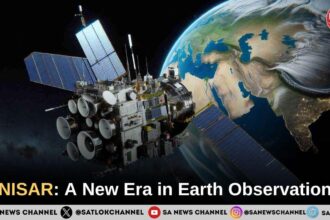Stare into the night sky, past the stars and galaxies, and you are looking at the deepest, oldest light in the universe. It isn’t visible to our eyes, but if we could see in the microwave spectrum, the entire sky would glow with a faint, almost perfectly uniform light. This is the Cosmic Microwave Background Radiation (CMBR), the residual heat from the Big Bang itself a fossilised echo of the universe’s fiery birth. It is arguably the most important discovery in modern cosmology, providing a direct snapshot of the infant universe and the bedrock upon which our understanding of cosmic evolution is built.
- Ancient History: The Universe in its Infancy
- Modern History: Prediction and Serendipitous Discovery
- The Current Picture: A Universe in High Definition
- COBE (Cosmic Background Explorer) Satellite (1989-1993):
- WMAP (Wilkinson Microwave Anisotropy Probe) (2001-2010):
- Planck Satellite (2009-2013):
- Future Possibilities: Unlocking Primordial Secrets
- The echoes of All creation Visible and Not
- FAQs
Ancient History: The Universe in its Infancy
To understand the CMBR’s origin, we must travel back in time to roughly 380,000 years after the Big Bang. In this early epoch, the universe was a vastly different place. It was not empty and cold, but a hot, dense, and completely opaque soup of subatomic particles. Protons, neutrons, and electrons zipped around in a high-energy plasma, so dense that photons of light couldn’t travel more than a few steps without scattering off a free electron. The universe was like a blinding, impenetrable fog.
As the universe expanded, it cooled. Eventually, it reached a critical temperature of about 3,000 Kelvin. At this point, it was cool enough for the free-floating electrons to be captured by protons, forming the first stable, neutral hydrogen atoms. This event is known as Recombination.
Suddenly, the fog cleared. With the free electrons now bound within atoms, the photons were liberated, free to travel across the cosmos unimpeded. This flood of light, released everywhere in the universe at once, is what we now see as the Cosmic Microwave Background. As the universe has continued to expand for the last 13.8 billion years, the wavelength of this primordial light has been stretched by a factor of about 1,100, shifting it from the visible/infrared spectrum into the low-energy microwave portion of the electromagnetic spectrum.
Modern History: Prediction and Serendipitous Discovery
The idea of a residual glow from a hot Big Bang was first predicted in the 1940s. Physicists George Gamow, Ralph Alpher, and Robert Herman were working on their model of nucleosynthesis and calculated that if the universe began in a hot, dense state, there should be some leftover radiation permeating all of space, with a temperature of around 5 Kelvin (−268∘C). However, their prediction was largely forgotten by the scientific community.
The story of its discovery is a classic tale of scientific serendipity. In 1964, two American radio astronomers, Arno Penzias and Robert Wilson, were working at Bell Labs in New Jersey with a large horn antenna designed for satellite communications. They were frustrated by a persistent, low-level hiss that they couldn’t eliminate from their receiver. The noise was isotropic (coming from all directions) and constant, day or night. They meticulously checked their equipment, even removing a pair of pigeons nesting in the antenna, but the noise remained.
Meanwhile, just a few miles away at Princeton University, a team led by Robert Dicke was independently working to build a radiometer specifically to search for the very radiation that Gamow had predicted. When Penzias and Wilson heard of Dicke’s work, the pieces clicked into place. Their mysterious noise was not an instrumental flaw but the ancient light of the universe itself. The discovery provided the “smoking gun” evidence for the Big Bang theory, effectively ending the debate with the rival Steady State theory. Penzias and Wilson were awarded the Nobel Prize in Physics in 1978 for their monumental discovery.
The Current Picture: A Universe in High Definition
The initial discovery showed the CMBR to be remarkably uniform. But theory predicted that there must be tiny temperature variations, or anisotropies, within this background light. These minuscule fluctuations were the seeds of all cosmic structure; the slightly denser, cooler spots acted as gravitational wells from which all the galaxies and galaxy clusters we see today would eventually form.
The quest to map these anisotropies has driven cosmology for the last three decades:
COBE (Cosmic Background Explorer) Satellite (1989-1993):
NASA’s COBE satellite first confirmed the CMBR’s perfect black-body spectrum, a textbook signature of a thermal remnant from a hot, early phase. Most importantly, in 1992, it produced the first map showing the predicted tiny temperature fluctuations variations of just one part in 100,000. This discovery, hailed as “seeing the face of God,” earned its lead scientists the 2006 Nobel Prize.
WMAP (Wilkinson Microwave Anisotropy Probe) (2001-2010):
WMAP provided a much higher-resolution view, refining our cosmic parameters with stunning precision. WMAP’s data helped establish the standard model of cosmology, known as the ΛCDM (Lambda-Cold Dark Matter) model. It precisely measured the age of the universe (13.77 billion years), its geometry (flat), and its composition: approximately 5% ordinary matter, 27% dark matter, and 68% dark energy.
Planck Satellite (2009-2013):
The European Space Agency’s Planck mission created the highest-resolution, most detailed map of the CMBR to date. It confirmed the findings of WMAP with even greater accuracy and tested the fundamental principles of cosmology, revealing a universe that is surprisingly simple in its fundamental makeup, yet filled with tantalising complexities.
Future Possibilities: Unlocking Primordial Secrets
While the CMBR has told us so much, its secrets are not yet exhausted. The next frontier is the study of its polarization and the orientation of the light waves. This polarization contains two types of patterns, named E-modes and B-modes.
E-modes, which have already been detected, are generated by the scattering of light off matter in the later universe. But the true holy grail is the detection of primordial B-modes. These specific, faint, swirling patterns in polarization are believed to be a unique signature of gravitational waves produced during Cosmic Inflation, a hypothetical period of exponential expansion that occurred a mere fraction of a second after the Big Bang.
Also Read: Discover the Latest Material Science Advancements in Steps
Detecting these primordial B-modes would provide direct evidence for inflation and open a window into the physics of the universe at energies far beyond what any particle accelerator on Earth could ever achieve. Experiments like the Simons Observatory and the Atacama Cosmology Telescope in Chile, as well as future space missions, are currently engaged in this monumental search.
From a theoretical afterglow to a serendipitous hiss, and now to a high-definition map of our cosmic origins, the Cosmic Microwave Background remains our most powerful tool for understanding the universe. It is a testament to how much we can learn by studying the faintest of whispers from the dawn of time.
The echoes of All creation Visible and Not
We as material beings can see or measure or comprehend the material echoes of creation. However, there are echoes of the creation of everything material and non-material that we could not comprehend. These echoes are stated in all our holy scriptures that we couldn’t realise, for the simple reason that we were not supposed to.
It was a Tatvadarshi Sant who was going to publicise these echoes and tell the true tale of creation to understand the true meaning of life, death, pain and suffering. By the grace of Kabir Saheb, Gareeb Dasji Maharaj had the true knowledge of creation and all encompassing knowledge written down in his Amar Granth Saheb.
Today, Saint Rampalji Maharaj is the only Tatvadarshi Sant who can tell us where these echoes are. He has done so in his Satsangs and books like Gyaan Ganga and Jeene Ki Rah. To understand why it took so long for this echoes to be opened up watch:
FAQs
1) What is the CMBR in simple terms?
Ans: The CMBR is the oldest light in the universe, a faint glow of microwave radiation that fills all of space. It’s essentially the leftover heat from the Big Bang, like an afterglow from the universe’s creation.
2) Why was the discovery of CMBR so important?
Ans: Its discovery was crucial because it provided the strongest evidence for the Big Bang theory. It perfectly matched the theory’s prediction that the universe began in an incredibly hot, dense state and has been cooling ever since.
3) What does CMBR prove?
Ans: The CMBR is considered the definitive proof of the Big Bang. Its near-perfect uniformity in all directions indicates that it originated from a single, hot, and dense point. The tiny temperature fluctuations within it also show the initial “seeds” that grew into galaxies and galaxy clusters.
4) Who discovered CMB radiation?
Ans: American radio astronomers Arno Penzias and Robert Wilson discovered the CMB radiation. They were awarded the Nobel Prize in Physics in 1978 for their discovery.
5) How does CMBR prove the universe is expanding?
Ans: The CMBR was originally very high-energy radiation (like light) released when the universe was hot. As the universe has expanded over billions of years, it has stretched the wavelengths of this radiation, causing it to “cool down” into the microwave spectrum we detect today. This stretching is a direct consequence of the expansion of space itself.
6) When was CMBR found?
The CMBR was discovered by accident in 1965.









